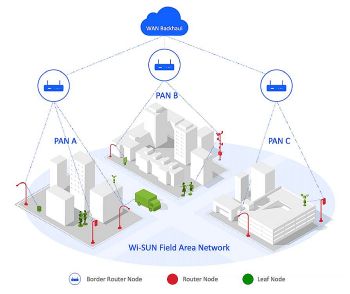Wi-SUN may well be the linchpin that turns street lighting into a scalable IoT umbrella offering a multitude of solutions beyond illumination.
Soumya Shyamasundar, Silicon Labs
According to the World Bank, legacy street lighting systems based on traditional technologies can account for as much as 65% of a city’s electricity consumption. The energy consumption, of course, adds to the amount of CO2 emissions in the atmosphere, and the fiscal impact of this waste is considerable.
Because LED lighting can yield up to 70% in energy savings, many governments are now replacing incandescent bulbs with LEDs in residential, public, and commercial spaces. LED lamps typically last up to 20 years. While it is understood that the ROI is substantial, their long lifespan is giving rise to new business models, including the augmentation of energy services through controls and sensors. The term for this process is smartification, the use of data to enhance previously purely physical products, turning them into smart service bundles (smart products).

In a citywide network, the chief purpose behind smartification thus far has been to enable a single application – street light management. Smart street lighting systems make possible adjustable lighting strategies and energy shaving—that is, leveling out peaks in energy use. Ditto for predictive maintenance through the provision of alerts for anomaly detection and malfunction.
Wireless connectivity and two-way communication can make lighting a scalable IoT umbrella for a multitude of other smart city features beyond illumination. Examples include CO2 sensors, public Wi-Fi, smart parking, and even gunshot detection. The connection of street lighting to a centralized management system (CMS) makes it possible to access live information and enable data sharing across multiple city departments.
Smart street lighting systems must operate in real-time and adapt quickly to shifting environmental conditions. To do so, they require connectivity that is scalable, secure, reliable, low-latency, long-range, high-throughput and two-way.
The key to smart lighting is all-inclusive design: Understanding the city-specific contextual lighting needs, the city’s long-term ambitions, and the visibility on usage and energy consumption. It is important to make sure the hardware is digitally enabled and ready to handle likely future requirements.
The typical smartification of streetlighting adds a wireless controller onto each luminaire. This controller communicates with a management application. Developers of end-to-end smart LED street lighting systems typically consider a few key elements within the IoT development platform:

Interoperability and scalability: These factor into the choice of a network topology and protocol. One widely used methodology in smart street lighting is mesh networking. Here, street light controllers communicate with each other and with gateways over a self-configuring and self-healing network. The gateway routes the communication to the CMS. Adding more devices creates multiple communication paths, thereby ensuring there is no single point of failure and thus making the network more robust. Mesh networks contrast with point-to-point networks where nodes communicate directly with the CMS via cellular links, arguably offering less redundancy.
A leading IPv6 sub-gigahertz mesh technology for smart city and smart utility applications is Wi-SUN, which stands for Wireless Smart Ubiquitous Network. Because of its advantages for large-scale outdoor IoT wireless communication networks, the City of London recently updated its lighting stock to incorporate Wi-SUN, citing the additional capability to enable new programs such as environmental monitoring.
Once the streetlights are deployed, the sensor node applications can work from any of the streetlights. This means it is possible to expand to any number of sensor applications depending upon city needs and how they may wish to deploy some of the emerging applications. A future-proof, extensible option, Wi-SUN gives cities a way to expand for 30-40 years.
Flexibility: Many smart city installations are still in their infancy. Wi-SUN technology provides the flexibility to integrate new, third-party devices. An open, standards-based technology, Wi-SUN allows any vendor to build a solution and deploy it. It ensures that cities have enough flexibility to make modifications, if they choose, and still gives them options to buy hardware and software from different suppliers, avoiding vendor lock-in.
Where cellular networks are typically subscription-based and in a licensed frequency band, Wi-SUN is a mesh network, residing in the ISM radio band – a free frequency spectrum. Once Wi-SUN has been deployed, it is up to the city management to manage the whole network. And because it is a mesh network, newer Wi-SUN nodes can be added without redeploying or rearchitecting the entire network.
Also worth considering is the limited lifespan of a cellular network. Cellular operators typically end-of-life their products within 10-12 years, a short time frame for smart city infrastructure. For context, it is estimated that around 30 million endpoints in the U.S. were orphaned by the phasing out of 2G networks.
Sub or 2.4 GHz: Designers must choose between sub-GHz or 2.4 GHz chips when considering the communication protocol or platform for the lighting controller itself. There are many 2.4-GHz mesh options available such as Zigbee and Bluetooth mesh. These are widely used in the home automation and commercial lighting sectors respectively because of their low-power mesh topology. Because the sub-gigahertz spectrum is less crowded than the 2.4 GHz area, emerging sub-gigahertz equipment offers longer range and lower RF noise. As smart cities are being built out, options that scale to hundreds of thousands of nodes will become a critical requirement, making Wi-SUN deployed in the sub-gigahertz spectrum attractive.
Security: Today’s chips are flexible in the sense that once an OEM builds a luminaire controller, the chip needn’t change when the next version of the specification arrives. Chip, firmware, software and applications can be updated via over-the-air (OTA) updates in wireless lighting infrastructure. So security issues that emerge can be corrected.
Cyber protection is especially important for critical infrastructure – clearly, hacked city streetlights are potentially dangerous. Chips should have a secure element integrated within their hardware to enable the secure storage of keys and passwords. Built-in security features include true random number generators, crypto engines, secure debugging features with lock/unlock, DPA countermeasures and anti-tamper chip designs.
With the above factors in mind, consider that the annual global energy consumption is estimated to top 580 million terajoules. According to the International Energy Agency, electricity demand will rise by 4.5% in 2021 (over 1,000 TWh). In a world that’s shifting from product to augmented product to platform, smart, connected solutions are helping to minimize the rising use of energy.
Cities of the not-so-distant future will be technologically smart, using software and wireless communication to optimize their use of energy and minimize consumption. Performance monitoring systems will deliver real-time insights into how public amenities are running, enabling better performance and less maintenance. And it all starts with smart LED lighting networks.






Leave a Reply